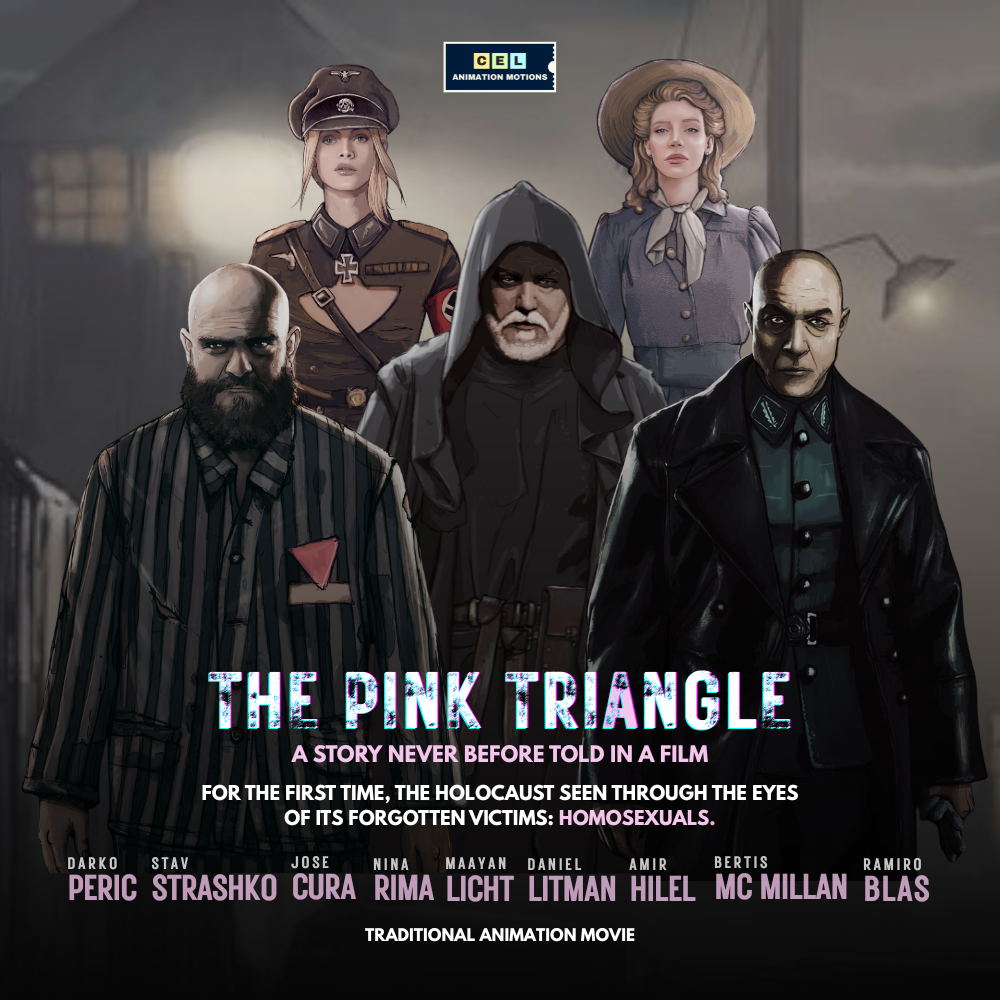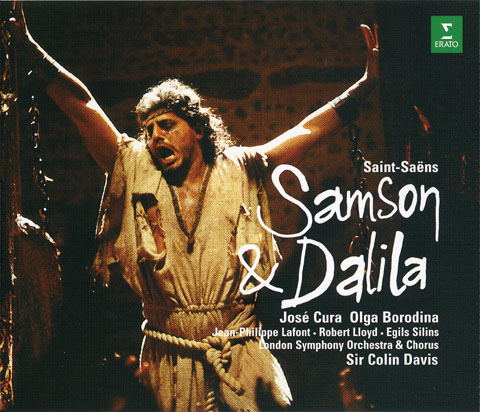|
|
|
|
A little different take on Samson this week: we look at the CD version released in 1998 featuring José Cura in a career defining effort, paired with Olga Borodina and under the baton of Sir Colin Davis. It is, arguably, the finest version released and still maintains the visceral thrill that comes from listening to a singer who understand his character, lives the role musically, and has the talent and authority to bring the role to life. Bravo! |
Congratulations on José Cura's latest artistic venture!
|
From Walt to Walton: The Rebirth of Hand-Drawn Animation When tradition meets the courage to innovate: Walton Zed's revolution in cel animation. The Art Insider Emanuela Zini 13 May 2025
In 1937, Walt Disney forever changed the course of cinema with Snow White and the Seven Dwarfs, the first full-length animated feature entirely hand-drawn. This pioneering work introduced the world to cel animation, a meticulous process involving transparent sheets, each capturing a single frame of motion. As digital techniques took over, this art form gradually faded. Now, in 2025, that classic magic finds a new voice and master in Walton Zed. An accomplished painter, academic, and expert in movement anatomy and visual storytelling, Walton Zed is breathing new life into a forgotten art form: handcrafted animation, meticulously created frame by frame with precision and passion. He is the creative force behind The Pink Triangle, a fully hand-drawn animated feature that delves into one of the most overlooked chapters of 20th-century history, the persecution of homosexuals during the Holocaust.
Being chosen as lead animator for this project by Cel Animation Motions is a profound honor. Bringing such a delicate subject to light using a technique that demands time, dedication, and respect is the challenge of my career says Walton Zed. The film is currently in production, backed by a $36 million budget and a team of over 700 professionals worldwide. Production began on September 18, 2024, and is set to span nearly three years, culminating in its premiere in Los Angeles 2027. Each scene comprises over 108,000 unique, hand-painted drawings. Eschewing CGI entirely, every frame reflects an almost obsessive attention to detail. Walton leads an international team operating across multiple time zones, enabling a continuous 24-hour production cycle, a unique approach in the animation world. “Working in cel animation today is like sculpting in the wind. But that’s its strength: every line, every movement, carries genuine expressive value. For a story like this, which speaks of memory and humanity, an equally authentic narrative form was necessary,” Walton explains. Supporting him is a high-profile team. Co-producers include José Cura, a living legend of opera who also composes the original score and plays a pivotal role in the film; Darko Peric, internationally beloved for his role as Helsinki in Money Heist; and Rubén Darío Salas, a multiple international award-winner ensuring the production’s sound and logistical quality. All under the strategic vision of producer David Guido Pietroni.
“David has assembled a team around me of such caliber that making mistakes is virtually impossible,” Walton admits with a smile. But who is Walton Zed beyond his role in the film? Graduating with top honors from the Academy of Fine Arts in Naples, he has taught animation for years between Naples and Los Angeles, mentoring entire generations of new artists. Now, he is preparing to move to Lucca to work on the film alongside American and other international production teams. This decision stems not only from artistic and logistical needs but also from a deep connection to the city, which Walton regards as a masterpiece of beauty and harmony, a place of immaculate architectural perfection, emblematic of Italian excellence. Lucca Comics & Games Festival Lucca has hosted the Lucca Comics & Games for nearly half a century, the world’s largest festival of animation and cosplay after Tokyo. In 2024, Walton had the opportunity to visit Lucca Comics & Games, where he met President Nicola Lucchesi and personally congratulated him on the scale and international prestige of the event, which Walton had previously attended in 2018 where he presented a short film blending animation and green screen techniques, and took part in a book signing session, an experience that marked the beginning of a lasting bond with the city. His cinematic ventures are not new: his animated short Selfiesh, a satirical take on the obsession with Botox, reached the finals of the Beverly Hills Film Festival. The short features performances by Amparo Roca and Ramiro Blas, with music composed by José Cura and produced by David Guido Pietroni for Cel Animation Motions.
When asked what The Pink Triangle represents for him, Walton responds without hesitation: It’s a story that needs to be told. But not just told, experienced, drawn, shared. I want the audience to feel the weight and beauty of every stroke, every emotion. Just like with Walt, when a cartoon could make you cry, laugh, and think From Walt to Walton, history repeats itself. But this time, it is art that guides memory. |
Tickets are now available
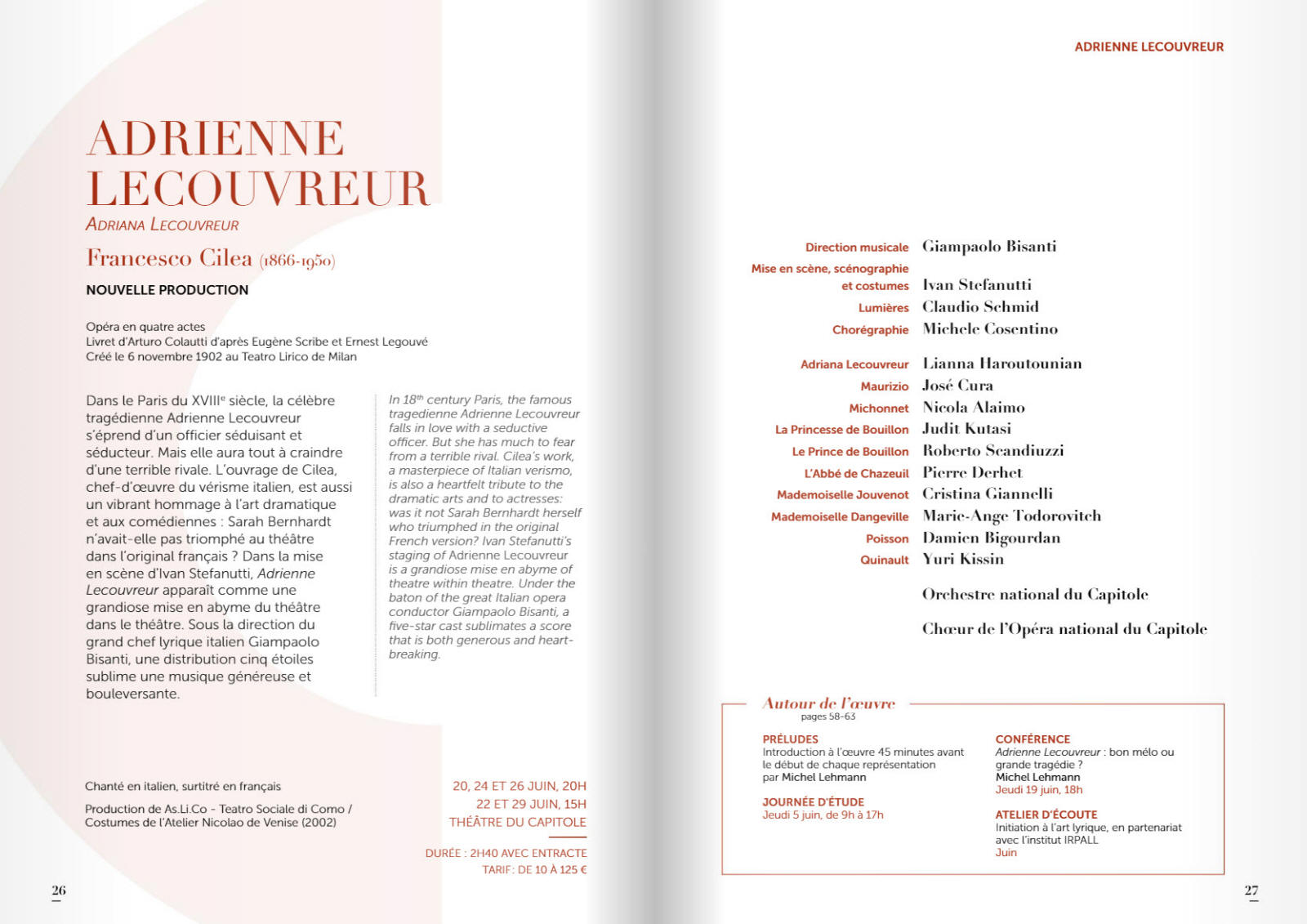
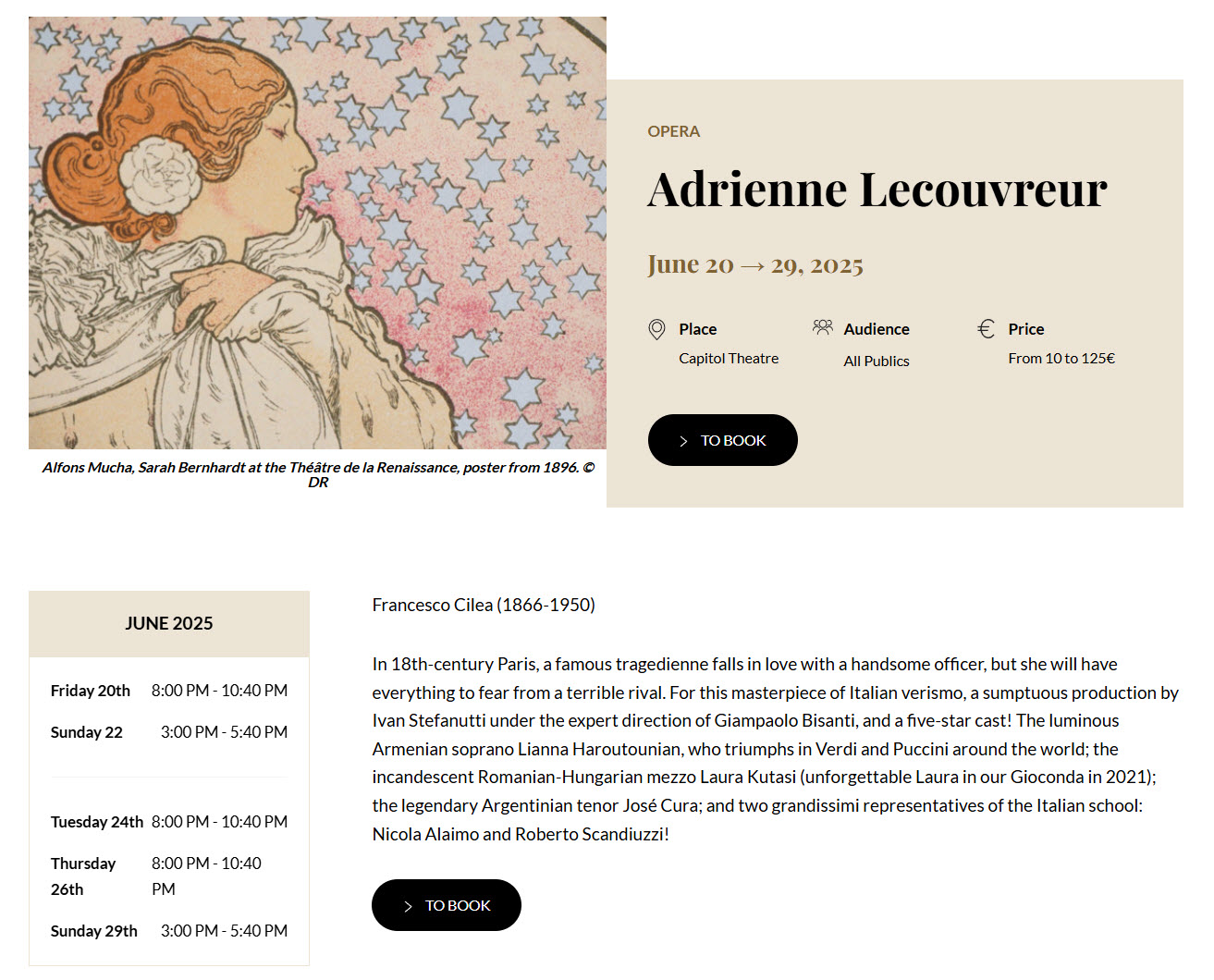
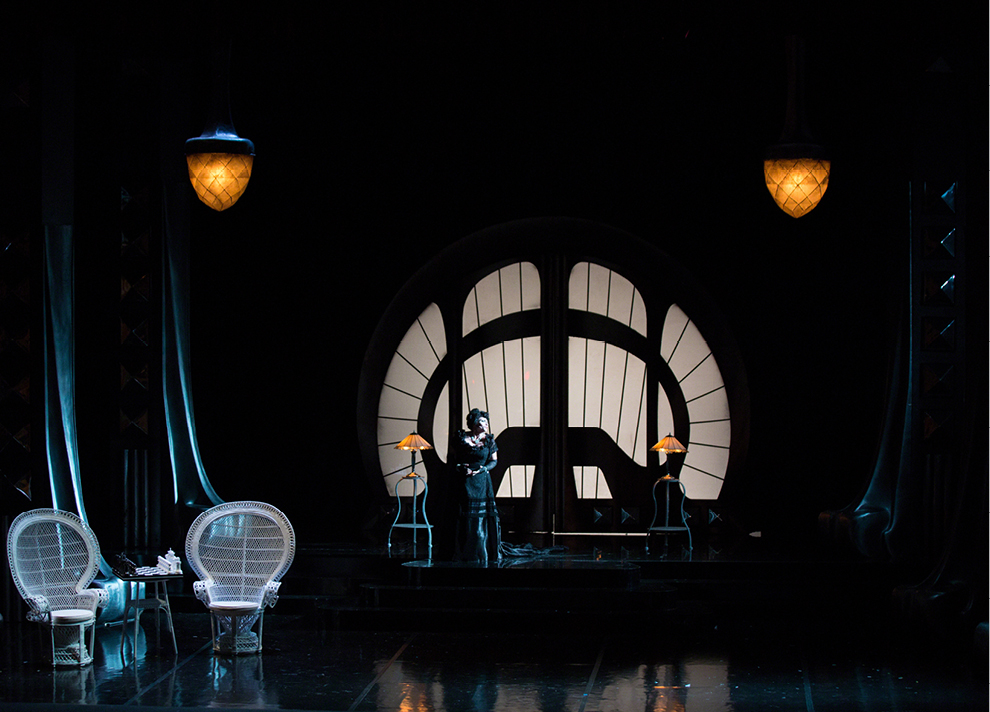

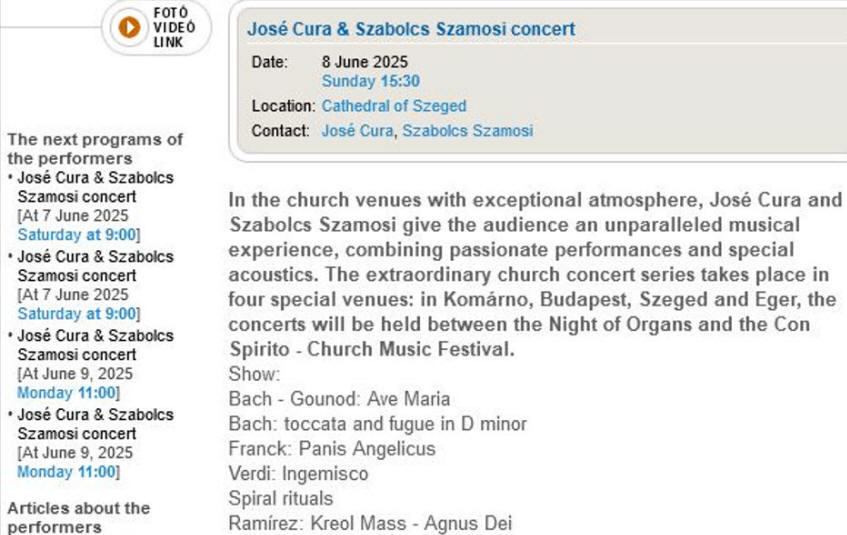
Peter Grimes - Estonia National Opera

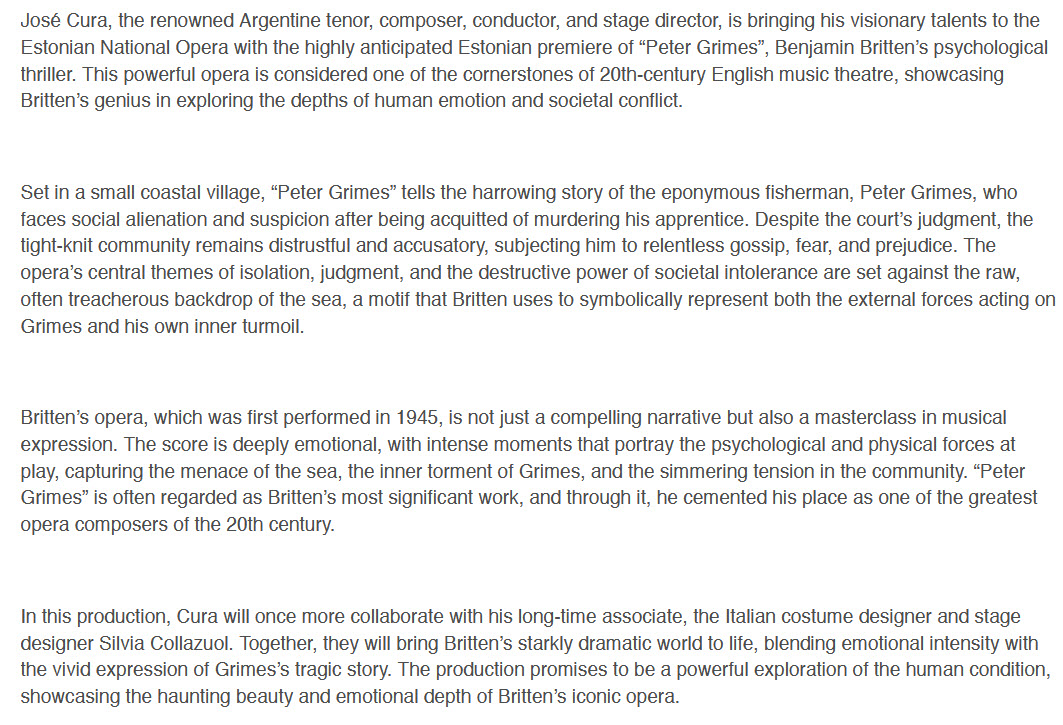
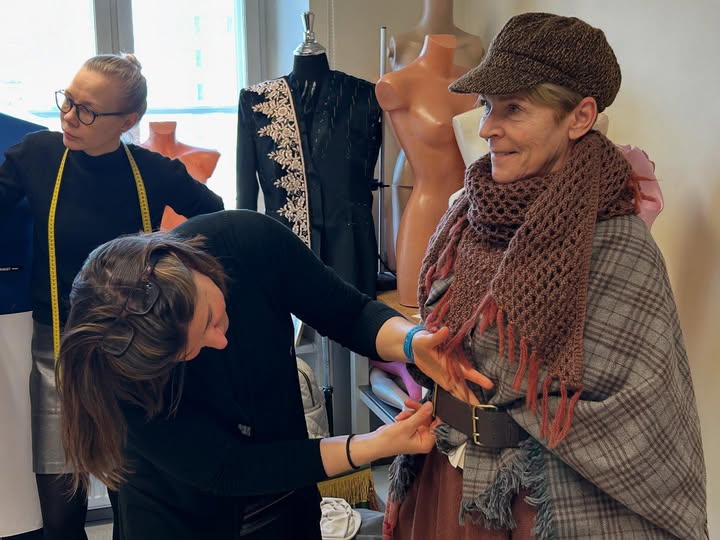
|
Samson et Dalila
Label - Erato
London Symphony Orchestra
and Chorus - Recorded August 1998, London UK Released November 1998
Performers: José Cura - Samson
Olga Borodina - Dalila
Jean-Philipp Lafont - Le Grand-Pretre de Dagon, Robert Lloyd - Un vieillard hebreu Egils Silins - Abimelech, Remi Garin, Un messager philistin, Gilles Ragon, Premier philistin, Olivier Lallouette, Deuxieme philistin
Approximately 124 minutes on two discs with notes, text and translation included.
Kira's Comment: If you can listen to Mr. Cura's ‘Vois Ma Misere, Helas! Vois Ma Detresse!' without tears, you have no heart.This is one opera I wanted to see Mr. Cura in for the longest time, and now I've seen it too many times to count and still can't believe how this singer is able to create such an unforgettable character. Mr. Cura is Samson. End of discussion. |
|

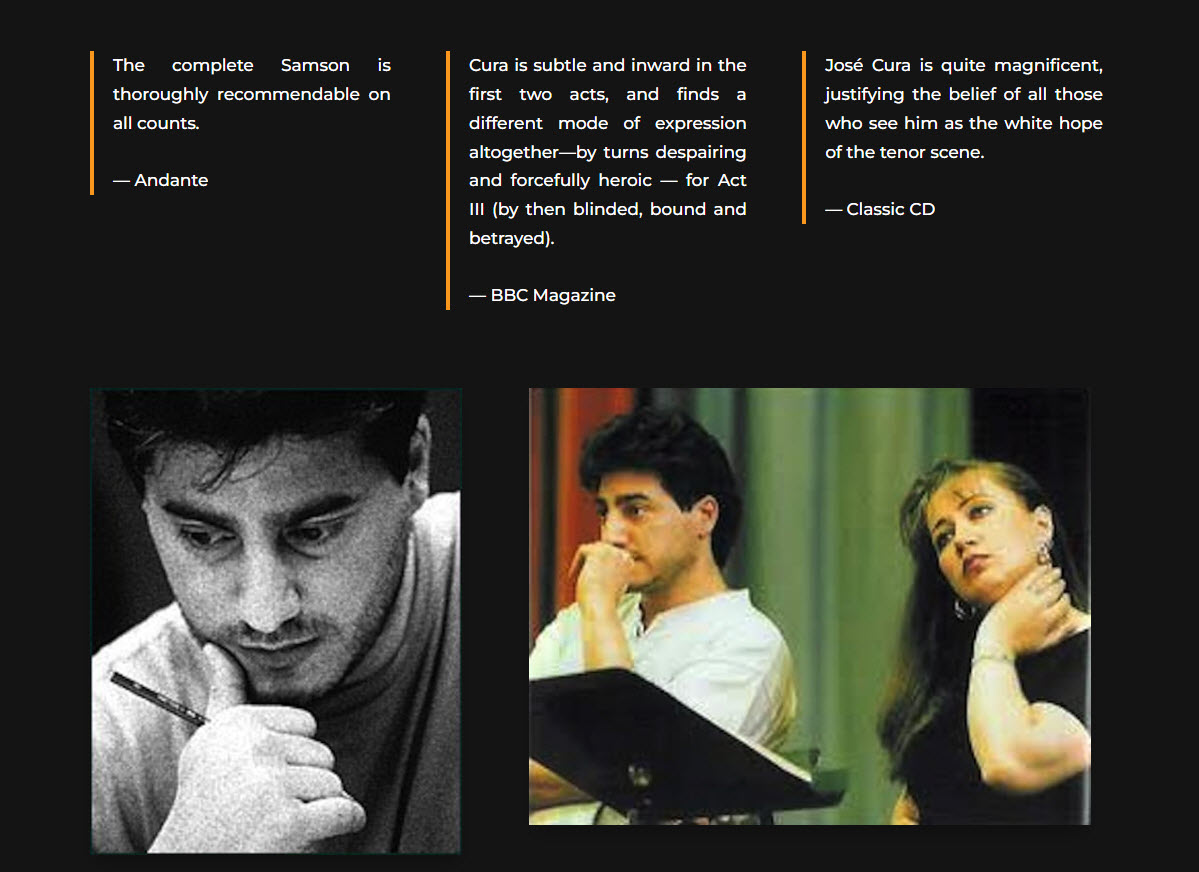
Track Listing
Danse Des Pretresses De DagonDisk One, Act 1
1. 'Dieu! Dieu D'Israel! Ecoute La Priere' – Chorus of Hebrews
2. 'Un Jour, De Nous Tu Detournas La Face' – Chorus of Hebrews
3. 'Arretez, O Mes Freres!' - Samson, Chorus of Hebrews
4. 'L'as-Tu Donc Oublie, Celui Dont La Puissance' - Samson, Chorus of Hebrews
5. 'Qui Donc Eleve Ici La Voix?' – Abimelech
6. 'C'est toi que sa bouche invective' - Samson, Chorus of Hebrews, Abimelech
7. 'Que Vois-je? Abimelech!' - Le Grande-Pretre, 1st & 2nd Philistins
8. 'Seigneur! La Troupe furieuse' - Un Messager Philistin, 1st & 2nd Philistins, Le Grand-Pretre
9. 'Hymne De Joie, Hymne De Delivrance' – Chorus of Hebrews, Un vieillard Hebrew
10. 'Voici Le Printemps Nous Portants Des Fleurs' – Chorus of young Hebrews
11. 'Je Viens Celebrer La Victoire' – Dalila, Samson, Un vieillard Hebrew
12.
13. 'Printemps Qui Commence' – Dalila, Un vieillard Hebrew
Disk Two, Act II
‘Qu'importe A Dalila Ton Or?' – Dalila, Le Grand-Pretre1. Prelude - LSO/Alastair Dawes/Sir Colin Davis
2. 'Samson, Recherchant Ma Presence' – Dalila
3. 'J'ai Gravi La Montagne' – Le Grand-Pretre, Dalila
4.
5.
'If faut, pour assouvir ma haine' – Dalila, Le Grand-Pretre6.
'Samson, me disais-tu, dans ces lieux' - Le Grand-Pretre , Dalila7.
'En Ces Lieux, Malgre Moi' – Samson, Dalila8.
'Qu'importe A Mon Coeur Desole' – Dalila, Samson9.
'Mon coeur s'ouvre a ta voix' - Dalila, Samson10.
'Mais!... Non! que dis-je?' - Dalila, SamsonDisk Two, Act III
‘Vois Ma Misere, Helas! Vois Ma Detresse!' - Samson, Chorus of Hebrews11.
12.
'L'aube Qui Blanchit Deja Les Coteaux' – Les Philistines13.
Bacchanale14.
'Salut! Salut Au Juge D'Israel' – Le Grand-Pretre, Samson, Les Philistines15.
'Laisse-Moi Prendre Ta Main' - Dalila, Les Philistines16.
'Allons, Samson, Divertis-nous' - Le Grand-Pretre, Samson, Les Philistines17.
'Viens, Dalila, Rendre Grace A Nos Dieux' - Le Grand-Pretre, Dalila, Les Philistines18. 'Guidez Ses Pas Vers Le Milieu Du Temple' - Le Grand-Pretre, Dalila, Samson, Les Philistines
Album Art:
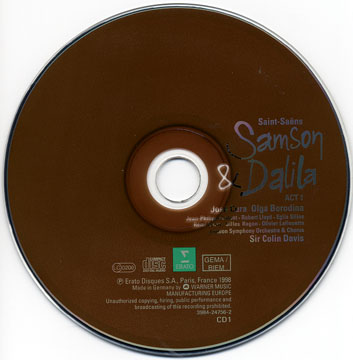
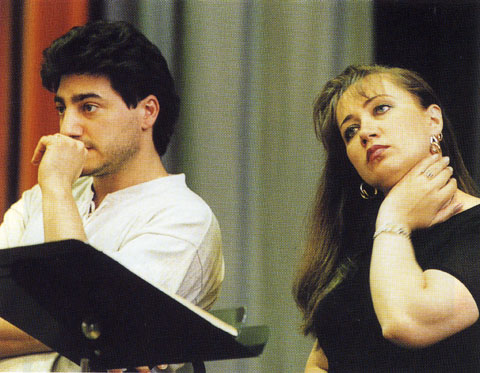

Reviews:
'Somewhat limited in the scope of its story, 'Samson' is the only Saint-Saëns opera to have survived in the repertoire, as well as one of the few by any Frenchman. Indeed, its biblical subject matter retarded its arrival in Paris until 1892, 15 years after Liszt had recognized its considerable musical merits and had facilitated its world debut in Weimar. These merits include a well-shaped seduction scene between the two title characters in the second act, as well as moments of wrath for Dalila and agony for Samson outside of this encounter. Both Cura's and Borodina's voices impressively depict this spectrum of emotions. Cura has a muscular tenor matching his physique, strongest at the top of his range, and a good actor's depth of characterization, while Borodina displays a heady mix of richness and delicacy in her soprano. Lafont credibly depicts a bigoted, wrathful zealot, Lloyd a sweet basso veteran. Much of the melodically loveliest music seems to belong to the Philistine women, sung entrancingly here by the chorus, and Davis gets the greatest possible drama through careful pacing and highlighted dynamics.' CDConnection
'José Cura is a world-class Samson. His powerfully masculine tenor, dark in timbre, ardent but never self-indulgent, has earned the young Argentinian a deserved reputation as a successor to Domingo. There is a thrill in his voice, a presence even on disc, which gives the uninitiated a sense of the committed, affecting impression he must make onstage. Cura sings with a genuine sense of discovery, and he shades his performance beautifully. The hushed desolation he projects as the blinded, enslaved Samson is a poignant surprise after the virile hero-lover....' Joanne Sydney Lessner, Opera News, February 1999
'And the climax of "mon coeur s'ouvre a ta voix" is surely one of the steamiest scenes captured on disc, though its sexiness has nothing to do with buff physiques and everything to do with gutsy, compelling musicianship... from Cura, the half tints of an heroic voice breathless with longing, caressing Saint-Saëns sinuous vocal lines, surging in to an exultant B-flat that speaks as much of erotic rapture as it does of a tenor nailing his money note.'
Marion Lignana Rosenberg, American Record Guide, Sep-Oct 1999
'Where Samson is concerned Cura provides the truly heroic timbre and dramatic declamation his part requires, and he is as sensitive as perhaps any Samson on disc, especially in Act 3 where he sings Vois ma misere, and the asides while taunted by Delilah later on, in a mezza voce as if communing with himself. In Act 2 he responds to her false expressions of love with true passion in his tone.' Alan Blyth, Gramophone, January 1999
'...Cura is the real thing, one of the most thrilling voices of this or any other generation and an artist of immense promise. San Francisco Opera fans discovered him early, as Don Jose in "Carmen." Now here he is in another of French opera's towering roles, and his interpretation ranks him with the best Samsons on record....The tenor's phrasing boasts the sort of natural ease that was more common before World War II, with ideal breath support dramatically deployed and a way of shaping words that is nothing short of miraculous.' Octavio Roca, San Francisco Chronicle, December 1998
'Cura is subtle and inward in the first two acts, and finds a different mode of expression altogether--by turns despairing and forcefully heroic -- for Act III (by then blinded, bound and betrayed).' Stephen Maddock, BBC Magazine, February 1999
'José Cura is quite magnificent, justifying the belief of all those who see him as the white hope of the tenor scene. He not only sounds like a hero, strong and intense, he also sings with subtlety and the large dynamic range that one expects in this role. His responses to Dalila in the climatic love scene are sung with astonishing refinement and restraint, all the more effective in the context of the steam coming off Dalila's tone.' Michael Tanner, Classic CD, February 1999
'The cast is exceptional. José
Cura, the latest Puccini tenor to come along, gives an intense performance as Samson. Throughout Acts I and II, Cura compels listening, and easily communicates the Israelite hero's emotional turmoil, troubled by his love of God and country, and his feelings for Dalila. Cura's musicianship is first-rate, and he works hard at vocal nuance.' Robert Workmon, Journal Now
'Samson et Dalila is having a renaissance, and not because it's great music. Though there are patches of seductive stuff, the opera is being pressed into service for the growing number of acclaimed mezzo-sopranos, since the role of Dalila is one of the few 19th-century star vehicles for that voice type. This recording boasts the vocally resplendent Russian mezzo Olga Borodina, but tenor José
Cura is the dominant presence, heard here in his strongest operatic recording yet. While his voice has been known to go slack at lower volumes, he seems uniformly secure. His characterization also has all the necessary heroism, along with thoughtful, touching pianissimos after Samson loses his strength. ... [C]onductor Colin Davis, the real star of the set, gives this opera the same shimmering aura of his great Berlioz interpretations, as if this were a poor man's Les Troyens. Shimmer comes courtesy of the fine London Symphony Orchestra and the slightly-too-reverberant recording venue, Walthamstow Assembly Hall.' David Patrick Stearns
'The complete Samson is thoroughly recommendable on all counts.' Marc Mandel, Andante
The Maturing of José Cura
The Argentinean has recorded Samson et Dalila under the direction of Sir Colin Davis. Cura proves authoritative and decisive. The Russian Olga Borodina excels as Dalila.
Armando M. Rapallo
Wednesday, December 23, 1998
Buenos Aires, Argentina
After his successful recordings devoted to the works of Puccini—with Plácido Domingo as mentor and conductor—and to selections of the Argentine repertoire (Anhelo), José Cura, the tenor from Rosario, has now tackled his first complete opera in a studio setting with Samson et Dalila, the most outstanding work of Camille Saint-Saëns, recording it between July 21 and 27 of this year at London’s Walthamstow Assembly Hall.
Cura talked with Clarín on the same day that he completed the recording sessions—conducted by the Englishman Sir Colin Davis—expressing his satisfaction with what had been accomplished. His approach to the recording underscores again the virtues already exhibited on both his Puccini CD-- a veritable masterpiece of delivery and diction—and his subsequent CD of eclectic selections. The difficult role of the Hebrew hero created by Saint-Saëns based on the libretto of Ferdinand Lemare, is taken on by the Argentinean tenor with impressive authority, especially if one bears in mind that his career has been relatively short.
Already in his first appearance-Arrêtez ô mes frères- Cura’s perfect attack and stupendous French diction stand out immediately, as do his skillful inflections in the …donner ma vie and his well-placed high notes at the beginning of the second act. Striking is the maturity of expression that he brings to his character’s strange mixture of passions; striking also his assimilation of text and score. Both demand a tenor with exceptional lyrical-dramatic traits. Cura introduces the wonderful passage of the millstone scene in the prison with plaintive accents and restrained vocal power. His interpretation of Vois ma misère, hélas… is exemplary in its placement of sound so that a very special atmosphere is achieved by the time of the final heroic plea in the Philistine temple.
For the Argentinean artist, this incorporation into the cramped group of recordings of Saint-Saëns’ work is turning into a huge success. As to his interpretive style, Cura’s approach to the leading role recalls the great Samson created by Ramón Vinay (recorded live in 1960 and for those with good memories of the Colón, his memorable appearance with Sir Thomas Beecham in 1958) while not detracting in the least from the memories of the great Samsons like Jon Vickers and Plácido Domingo.
Samson… cannot have a mediocre Dalila. The Russian singer Olga Borodina is a heroine of excellent vocal resources and innate expressiveness. From her Amour! Viens aider ma faiblesse! to the splendid Mon coeur s’ouvre à ta voix, Borodina offers musical subtlety and a range which-- because of the amplitude and generous display of vocal ability-- is perfect for the part of Dalila. Sir Colin Davis’ musical direction is suitable. Concerning the rest of the cast, the nobility of the singing by English bass Robert Lloyd as the proud Old Hebrew must be emphasized. (translated by Monica)
Legacy
Subscribe: https://www.youtube.com/@josecuralegacy/playlists

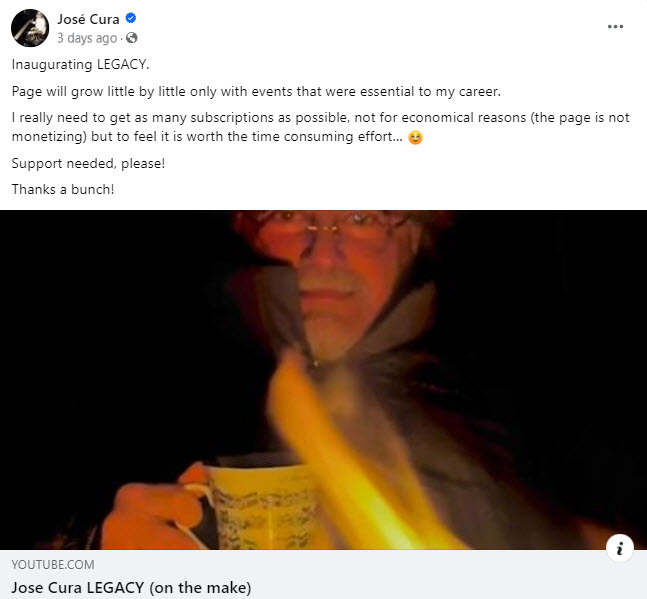
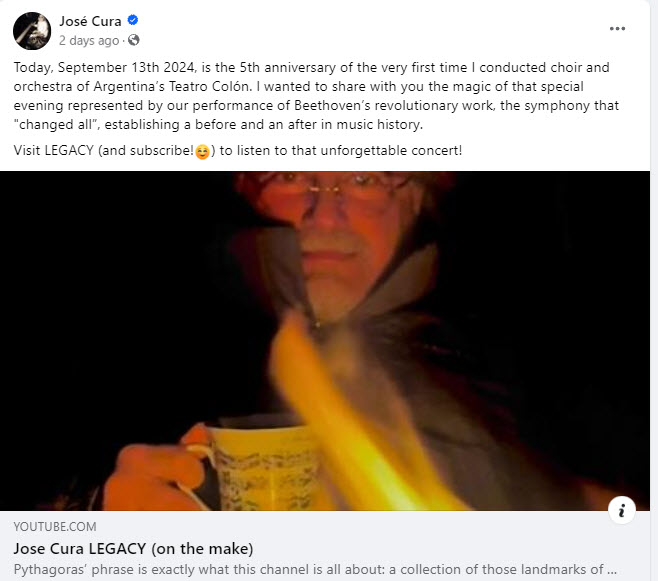
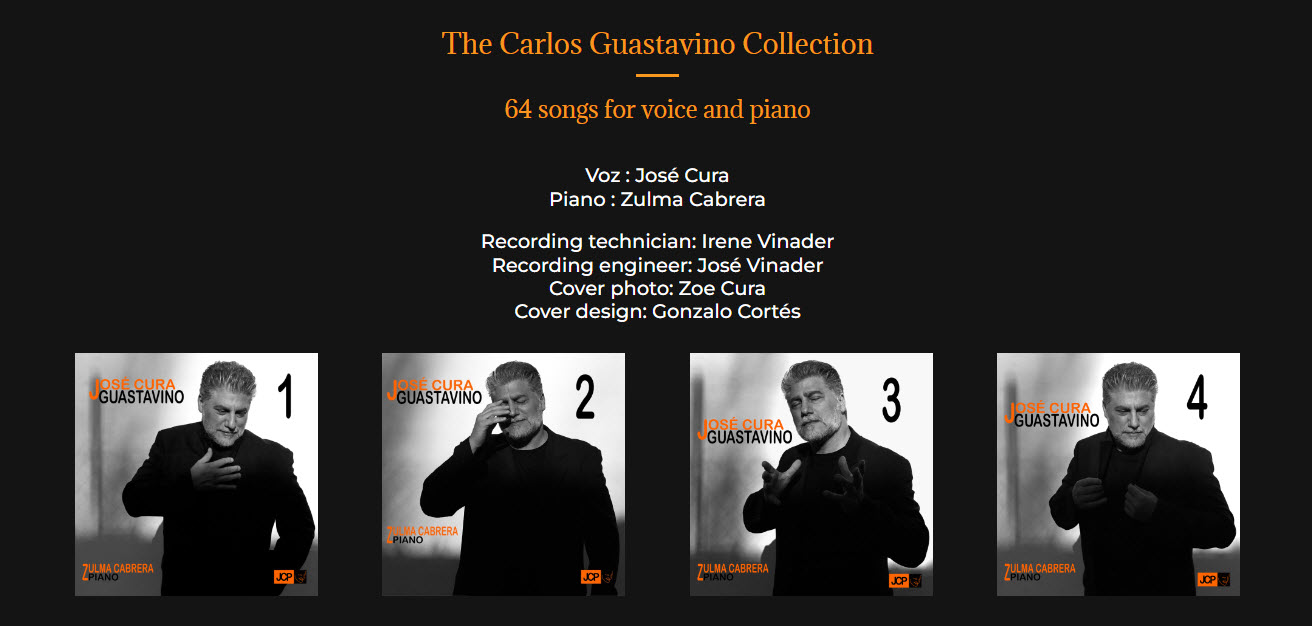
Available on iTunes and at Amazon
Resources
|
|
|
Visit at JoseCura.com |
Find Cura on Wikipedia!
This page is an UNOFFICIAL fan page. Mistakes found in these pages are our mistakes and our responsibility.
This fan page is dedicated to promoting the artistry of José Cura. We are supported and encouraged by Cura fans from around the world: without these wonderful people, we wouldn't be able to keep up with the extraordinary career of this fabulous musical talent.
Note that some of the material included on these pages are covered by copyright laws. Please respect the rights of the owners.
About Bravo Cura |Bio Information |Concerts 1 |Concerts 2 |Discography |Opera Works |Opera Work 2 |Press
Last Updated: Sunday, May 18, 2025 © Copyright:
Kira


